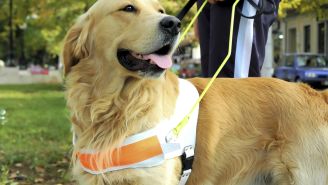Emotional support animals (ESAs) seem to make the news weekly, whether it’s a peacock trying to board a plane or a duck wandering the aisles inflight. That's because more people than ever are traveling with their animals—typically smaller dogs—to help manage mental and psychiatric disabilities, like anxiety, depression or panic attacks. While these animals can provide assistance and comfort to people with mental health issues, not every claim of emotional support is valid.
Service animals vs. ESAs
The distinction between service animals and ESAs is important. Protected under the Americans with Disabilities Act, service animals can only be dogs, or in some rare instances, miniature horses. These animals must be trained for a purpose, like assisting people with visual impairments, hearing difficulties, seizure conditions or psychiatric disorders such as PTSD. Because they are specifically trained, these dogs are not considered pets and are therefore allowed in public spaces that often prohibit animals.
In contrast, an ESA can be any type of animal, including a family pet. They provide support for those suffering from emotional and psychiatric disabilities. Often these animals can be part of a treatment program, but they are not trained for a specific purpose. Travelers can request permission to take their ESA aboard a flight to help with anxiety, among other conditions. Their access to public spaces is typically much more restricted.
“The ability to keep or bring an emotional support animal is limited to housing or airlines,” explains Rebecca F. Wisch, Associate Editor/Clinical Staff Attorney for the Animal Legal & Historical Center at Michigan State University. “Emotional support animals are not allowed in other public places under any federal or state law.”
The registration racket
Currently there are no federally recognized certification programs for either guide dogs or ESAs. This has spawned a flood of online companies claiming to provide ESA documentation for a fee, typically under $200. Some of these sites ask a handful of questions about mental health, but do not require proof of mental or emotional disability from a certified professional. Because of this, you can register any type of animal, including peacocks and ducks.
Documents sold by these sites are not considered valid by the government, and their lax standards put people with legitimate ESA needs at a disadvantage, especially if they have to travel.
“The people that really need service animals are being victimized by these frauds. This current backlash is going to make it more difficult for them." says Hal Herzog, PhD, Professor Emeritus of Psychology at Western Carolina University and author of Some We Love, Some We Hate, Some We Eat: Why It’s So Hard to Think Straight About Animals.
ESAs and airplanes
Adding to the confusion and controversy surrounding ESAs: every airline has different rules about what's allowed on board. All airlines require a doctor’s note showing:
- You have a mental or emotional disability
- Your doctor is licensed and you are currently undergoing treatment with them
- You need the animal for emotional support
However, only Delta currently has a list of animals prohibited on their aircrafts. Most decisions are left to the airlines' discretion, which often leads to disgruntled passengers and outrageous news stories.
Lending to the skepticism that surrounds the use of ESAs, there's little evidence they're actually necessary in the air. While they may help airline travelers with psychiatric conditions, scientific research has yet to be done inflight to back up those claims.
“In terms of studies on whether people actually do better on airplanes if they have their emotional support animal, shockingly there are no studies on that,” says Herzog. “In my view, there is not very good evidence that shows that pets have long-term impacts on their owners' health and psychological wellbeing. However, there is very good evidence that interacting with animals, especially dogs, can have very good short-term impacts, particularly on stress.”
How to travel with an ESA
If you do need to travel with an ESA, the most important thing is to get valid documentation from your mental health provider that you are currently undergoing treatment and your animal is essential to your therapy. Most airlines now require up-to-date veterinary records, too. Submit all documentation at least 48 hours before your flight. Animals also must fit on your lap or at your feet.
Keep in mind how traveling may impact your ESA, as well. “An ESA by definition is an untrained animal. An untrained animal may be very stressed on a plane,” notes Wisch. “If the animal then poses a threat or disrupts the plane due to stress of being confined around so many people, the passenger might not be able to travel with the ESA.”
If you are unsure whether your animal can qualify as an ESA, speak to your doctor and call your airline well in advance of your flight. By taking all the necessary steps, traveling with your animal can be a calm and stress-free experience, with no media attention required.

